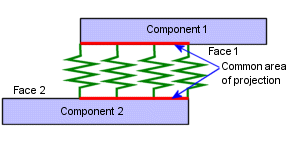A Spring
 connects parallel planar faces or
concentric cylindrical faces with springs that can resist tension only (cables), compression
only, or tension and compression.
connects parallel planar faces or
concentric cylindrical faces with springs that can resist tension only (cables), compression
only, or tension and compression.
Spring connectors for surfaces and sheet metal bodies are available
for static, frequency, dynamic, and buckling studies. The feature is not available
for composite shells. For nonlinear studies, define connectors between two vertices
or reference points only.
Type

|
Compression Extension
|
Resists tension and compression.
Available for static, frequency, buckling, and nonlinear studies.
|

|
Compression only
|
Resists compression only.
Available for static and nonlinear studies. |

|
Extension only
|
Resists tension only. Available
for static and nonlinear studies. |
| |
Flat parallel faces
|
|
 Planar Face or Edge of Component 1
Planar Face or Edge of Component 1
|
Planar faces or edges of shells from a
body. Edges of shells refer to
edges of surface bodies and the face containing the
smallest dimension for sheet metal bodies. The
program meshes the sheet metal bodies with shell
elements and converts the face of the sheet metal
containing the sheet metal thickness into an edge.
|
|
 Parallel Face or Edge of Component 2
Parallel Face or Edge of Component 2
|
Planar faces from another body or edges
of shell. These faces should be parallel to the faces
selected above. If you selected linear edges for both
selections, they should be straight and parallel to the
edges selected above.
|
|
| |
Concentric cylindrical faces
|
|
 Cylindrical Faces of Component 1
Cylindrical Faces of Component 1
|
Cylindrical faces or circular edges of
solids or shells.
|
|
 Cylindrical Faces of Component 2
Cylindrical Faces of Component 2
|
Cylindrical faces or circular edges of
shells from another body. These faces or edges should be
concentric to the faces or edges selected above.
|
|
| |
Between vertices
|
|
 Vertex or point for first location
Vertex or point for first location
|
|
|
 Vertex or point for second location
Vertex or point for second location
|
Select a vertex or a reference point
from the same or different component or a body.
|
|
Symbol Settings
| |
Edit Color
|
Select a color for the
symbols. |

|
Symbol size
|
Set the size of the symbols.
|
| |
Show preview
|
Toggles the display of the
connector symbols in the graphics area. |
Tips
- Springs are introduced in the common area of projection of
the faces from one body on the faces from the other body. If there is no
common area, the software cannot create the spring.
If
you selected an edge of a shell from a body and face of a solid or edge
of a shell from another body, springs are introduced along the common
length of projection of the edges from one body to edges or faces of
another body.

- You can split one or both faces by projecting one face onto
the other. Define a spring between the new, aligned faces.
- When viewing results, plot the deformed shape with 1.0
scale factor to ensure that there is no interference between components.
When interference occurs, the results are not valid. Define contact
conditions between the interfering faces before re-running the study.
- When listing spring connector forces, the axial and shear forces are
computed based on the relations:

Where Fx, Fy, and Fz are the spring forces with respect to the global
coordinate system, and u = {ux, uy, uz} is the unit vector positioned along the
spring. A negative axial force indicates a spring in compression, whereas a positive
axial force indicates a spring in tension.
When a spring connector is applied between flat or cylindrical
faces, the software lists the spring forces as the sum of the individual spring
elements connecting the two faces.